Spatio-Temporal Analysis of the Effects of Human Activities on Habitat Quality: A Case Study of Guiyang City, Guizhou Province, China
Abstract
1. Introduction
2. Materials and Methods
2.1. Study Area
2.2. Data Sources
2.3. Methods
2.3.1. Research Framework
2.3.2. The Habitat Quality Model
2.3.3. Human Footprint Index (HFI)
2.3.4. Global Moran’s I
2.3.5. Bivariate Local Moran’s I
2.3.6. Zoning Management Scheme
3. Results
3.1. Spatio-Temporal Patterns of Habitat Quality
3.2. Spatio-Temporal Patterns of Human Footprint
3.3. Spatio-Temporal Relationships between Habitat Quality and Human Footprint
3.4. Spatial Zoning Results for Guiyang City
4. Discussion
4.1. Effects of Human Activities on Habitat Quality
4.2. Implications for the Development of Guiyang City
4.3. Limitations of Uncertainty and Future Recommended Work
5. Conclusions
Author Contributions
Funding
Institutional Review Board Statement
Informed Consent Statement
Data Availability Statement
Conflicts of Interest
References
- Bloom, D.E.; Canning, D.; Fink, G. Urbanization and the Wealth of Nations. Science 2008, 319, 772–775. [Google Scholar] [CrossRef] [PubMed]
- Liu, Z.; Gan, X.; Dai, W.; Huang, Y. Construction of an Ecological Security Pattern and the Evaluation of Corridor Priority Based on ESV and the “Importance–Connectivity” Index: A Case Study of Sichuan Province, China. Sustainability 2022, 14, 3985. [Google Scholar] [CrossRef]
- Fischer, J.; Lindenmayer, D.B. Landscape modification and habitat fragmentation: A synthesis. Glob. Ecol. Biogeogr. 2007, 16, 265–280. [Google Scholar] [CrossRef]
- Li, Z.-T.; Li, M.; Xia, B.-C. Spatio-temporal dynamics of ecological security pattern of the Pearl River Delta urban agglomeration based on LUCC simulation. Ecol. Indic. 2020, 114, 106319. [Google Scholar] [CrossRef]
- McAtee, J.W.; Drawe, D.L. Human impact on beach and foredune microclimate on North Padre Island, Texas. Environ. Manag. 1981, 5, 121–134. [Google Scholar] [CrossRef]
- Zhang, Y.; Song, W.; Fu, S.; Yang, D. Decoupling of land use intensity and ecological environment in Gansu province, China. Sustainability 2020, 12, 2779. [Google Scholar] [CrossRef]
- Liu, Y.; Fang, F.; Li, Y. Key issues of land use in China and implications for policy making. Land Use Policy 2014, 40, 6–12. [Google Scholar] [CrossRef]
- Peng, J.; Lv, D.; Dong, J.; Liu, Y.; Liu, Q.; Li, B. Processes coupling and spatial integration: Characterizing ecological restoration of territorial space in view of landscape ecology. J. Nat. Resour. 2020, 35, 3–13. [Google Scholar]
- Xu, Y.; Xu, X.; Tang, Q. Human activity intensity of land surface: Concept, methods and application in China. J. Geogr. Sci. 2016, 26, 1349–1361. [Google Scholar] [CrossRef]
- Duan, Q.L.; Luo, L.H. Summary and prospect of spatialization method of human activity intensity:taking the Qinghai-Tibet Plateau as an example. J. Glaciol. Geocryol. 2021, 43, 1582–1593. [Google Scholar]
- McCloskey, J.M.; Heather, S. A Reconnaissance-Level Inventory of the Amount of Wilderness Remaining in the World. Ambio 1989, 18, 221–227. [Google Scholar]
- Vitousek, P.M.; Ehrlich, P.R.; Ehrlich, A.H.; Matson, P.A. Human Appropriation of the Products of Photosynthesis. BioScience 1986, 36, 368–373. [Google Scholar] [CrossRef]
- Yang, F.; Matsushita, B.; Yang, W.; Fukushima, T. Mapping the human footprint from satellite measurements in Japan. ISPRS J. Photogramm. Remote Sens. 2014, 88, 80–90. [Google Scholar] [CrossRef]
- Mu, H.; Li, X.; Wen, Y.; Huang, J.; Du, P.; Su, W.; Miao, S.; Geng, M. A global record of annual terrestrial Human Footprint dataset from 2000 to 2018. Sci. Data 2022, 9, 1–9. [Google Scholar] [CrossRef] [PubMed]
- Sanderson, E.W.; Jaiteh, M.; Levy, M.A.; Redford, K.H.; Wannebo, A.V.; Woolmer, G. The Human Footprint and the Last of the Wild: The human footprint is a global map of human influence on the land surface, which suggests that human beings are stewards of nature, whether we like it or not. BioScience 2002, 52, 891–904. [Google Scholar] [CrossRef]
- Khelifa, R.; Mahdjoub, H.; Samways, M.J. Combined climatic and anthropogenic stress threaten resilience of important wetland sites in an arid region. Sci Total Environ. 2022, 806, 150806. [Google Scholar] [CrossRef]
- González-Abraham, C.; Ezcurra, E.; Garcillán, P.P.; Ortega-Rubio, A.; Kolb, M.; Bezaury Creel, J.E. The human footprint in Mexico: Physical geography and historical legacies. PLoS ONE 2015, 10, e0121203. [Google Scholar] [CrossRef]
- Jacobson, A.P.; Riggio, J.M.; Tait, A.; E. M. Baillie, J. Global areas of low human impact (‘Low Impact Areas’) and fragmentation of the natural world. Sci. Rep. 2019, 9, 14179. [Google Scholar] [CrossRef]
- Venter, O.; Sanderson, E.W.; Magrach, A.; Allan, J.R.; Beher, J.; Jones, K.R.; Possingham, H.P.; Laurance, W.F.; Wood, P.; Fekete, B.M. Global terrestrial Human Footprint maps for 1993 and 2009. Sci. Data 2016, 3, 1–10. [Google Scholar] [CrossRef]
- Li, S.; Zhang, Y.; Wang, Z.; Li, L. Mapping human influence intensity in the Tibetan Plateau for conservation of ecological service functions. Ecosyst. Serv. 2018, 30, 276–286. [Google Scholar] [CrossRef]
- Woolmer, G.; Trombulak, S.C.; Ray, J.C.; Doran, P.J.; Anderson, M.G.; Baldwin, R.F.; Morgan, A.; Sanderson, E.W. Rescaling the Human Footprint: A tool for conservation planning at an ecoregional scale. Landsc. Urban Plan. 2008, 87, 42–53. [Google Scholar] [CrossRef]
- Hall, L.S.; Krausman, P.R.; Morrison, M.L. The Habitat Concept and a Plea for Standard Terminology. Wildl. Soc. Bull. (1973–2006) 1997, 25, 173–182. [Google Scholar]
- Johnson, M.D. Measuring Habitat Quality: A Review. Condor 2007, 109, 489–504. [Google Scholar] [CrossRef]
- Bai, L.; Xiu, C.; Feng, X.; Liu, D. Influence of urbanization on regional habitat quality:a case study of Changchun City. Habitat Int. 2019, 93, 102042. [Google Scholar] [CrossRef]
- Hamada, S.; Ohta, T. Seasonal variations in the cooling effect of urban green areas on surrounding urban areas. Urban For. Urban Green. 2010, 9, 15–24. [Google Scholar] [CrossRef]
- Haase, D.; Nuissl, H. Does urban sprawl drive changes in the water balance and policy?: The case of Leipzig (Germany) 1870–2003. Landsc. Urban Plan. 2007, 80, 1–13. [Google Scholar] [CrossRef]
- Newbold, T.; Hudson, L.N.; Hill, S.L.; Contu, S.; Lysenko, I.; Senior, R.A.; Börger, L.; Bennett, D.J.; Choimes, A.; Collen, B. Global effects of land use on local terrestrial biodiversity. Nature 2015, 520, 45–50. [Google Scholar] [CrossRef]
- Williams, B.A.; Venter, O.; Allan, J.R.; Atkinson, S.C.; Rehbein, J.A.; Ward, M.; Di Marco, M.; Grantham, H.S.; Ervin, J.; Goetz, S.J.; et al. Change in Terrestrial Human Footprint Drives Continued Loss of Intact Ecosystems. One Earth 2020, 3, 371–382. [Google Scholar] [CrossRef]
- Lewis, N.S.; Fox, E.W.; DeWitt, T.H. Estimating the distribution of harvested estuarine bivalves with natural-history-based habitat suitability models. Estuar. Coast. Shelf Sci. 2019, 219, 453–472. [Google Scholar] [CrossRef]
- Zhang, H.; Sun, T.; Xue, S.; Yang, W.; Shao, D. Habitat-mediated, density-dependent dispersal strategies affecting spatial dynamics of populations in an anthropogenically-modified landscape. Sci. Total Environ. 2018, 625, 1510–1517. [Google Scholar] [CrossRef]
- Sannigrahi, S.; Chakraborti, S.; Joshi, P.K.; Keesstra, S.; Sen, S.; Paul, S.K.; Kreuter, U.; Sutton, P.C.; Jha, S.; Dang, K.B. Ecosystem service value assessment of a natural reserve region for strengthening protection and conservation. J. Environ. Manag. 2019, 244, 208–227. [Google Scholar] [CrossRef] [PubMed]
- Tianhong, L.; Wenkai, L.; Zhenghan, Q. Variations in ecosystem service value in response to land use changes in Shenzhen. Ecol. Econ. 2010, 69, 1427–1435. [Google Scholar] [CrossRef]
- Kong, L.; Zhang, L.; Zheng, H.; Xu, W.; Xiao, Y.; Ouyang, Z. Driving forces behind ecosystem spatial changes in the Yangtze River Basin. Acta Ecol. Sin. 2018, 38, 741–749. [Google Scholar]
- Dai, L.; Li, S.; Lewis, B.J.; Wu, J.; Yu, D.; Zhou, W.; Zhou, L.; Wu, S. The influence of land use change on the spatial–temporal variability of habitat quality between 1990 and 2010 in Northeast China. J. For. Res. 2019, 30, 2227–2236. [Google Scholar] [CrossRef]
- Feng, S.; Sun, R.; Chen, L. Spatio-temporal variability of habitat quality based on land use pattern change in Beijing. Acta Ecol. Sin. 2018, 38, 4167–4179. [Google Scholar]
- Berta Aneseyee, A.; Noszczyk, T.; Soromessa, T.; Elias, E. The InVEST Habitat Quality Model Associated with Land Use/Cover Changes: A Qualitative Case Study of the Winike Watershed in the Omo-Gibe Basin, Southwest Ethiopia. Remote Sens. 2020, 12, 1103. [Google Scholar] [CrossRef]
- Gao, Y.; Ma, L.; Liu, J.; Zhuang, Z.; Huang, Q.; Li, M. Constructing Ecological Networks Based on Habitat Quality Assessment: A Case Study of Changzhou, China. Sci. Rep. 2017, 7, 46073. [Google Scholar] [CrossRef]
- Choudhary, A.; Deval, K.; Joshi, P.K. Study of habitat quality assessment using geospatial techniques in Keoladeo National Park, India. Environ. Sci. Pollut. Res. 2021, 28, 14105–14114. [Google Scholar] [CrossRef]
- Qing, L.; Yong, Z.; Cunningham, M.A.; Tao, X. Spatio-temporal Changes in Wildlife Habitat Quality in the Middle and Lower Reaches of the Yangtze River from 1980 to 2100 based on the InVEST Model. J. Resour. Ecol. 2021, 12, 43–55. [Google Scholar] [CrossRef]
- Zhang, Y.; Jiang, Z.; Li, Y.; Yang, Z.; Wang, X.; Li, X. Construction and Optimization of an Urban Ecological Security Pattern Based on Habitat Quality Assessment and the Minimum Cumulative Resistance Model in Shenzhen City, China. Forests 2021, 12, 847. [Google Scholar] [CrossRef]
- McKinney, M.L. Urbanization, Biodiversity, and Conservation: The impacts of urbanization on native species are poorly studied, but educating a highly urbanized human population about these impacts can greatly improve species conservation in all ecosystems. BioScience 2002, 52, 883–890. [Google Scholar] [CrossRef]
- Nuissl, H.; Haase, D.; Lanzendorf, M.; Wittmer, H. Environmental impact assessment of urban land use transitions—A context-sensitive approach. Land Use Policy 2009, 26, 414–424. [Google Scholar] [CrossRef]
- Liu, Y.; Huang, X.; Yang, H.; Zhong, T. Environmental effects of land-use/cover change caused by urbanization and policies in Southwest China Karst area—A case study of Guiyang. Habitat Int. 2014, 44, 339–348. [Google Scholar] [CrossRef]
- Peng, J.; Pan, Y.; Liu, Y.; Zhao, H.; Wang, Y. Linking ecological degradation risk to identify ecological security patterns in a rapidly urbanizing landscape. Habitat Int. 2018, 71, 110–124. [Google Scholar] [CrossRef]
- Sun, J.; Huang, J.; Wang, Q.; Zhou, H. A method of delineating ecological red lines based on gray relational analysis and the minimum cumulative resistance model: A case study of Shawan District, China. Environ. Res. Commun. 2022, 4, 045009. [Google Scholar] [CrossRef]
- Huang, X.; Wang, H.; Shan, L.; Xiao, F. Constructing and optimizing urban ecological network in the context of rapid urbanization for improving landscape connectivity. Ecol. Indic. 2021, 132, 108319. [Google Scholar] [CrossRef]
- Leu, M.; Hanser, S.E.; Knick, S.T. The human footprint in the west: A large-scale analysis of anthropogenic impacts. Ecol. Appl. 2008, 18, 1119–1139. [Google Scholar] [CrossRef]
- Fang, C.; Lin, X. The eco-environmental guarantee for China’s urbanization process. J. Geogr. Sci. 2009, 19, 95–106. [Google Scholar] [CrossRef]
- Sallustio, L.; De Toni, A.; Strollo, A.; Di Febbraro, M.; Gissi, E.; Casella, L.; Geneletti, D.; Munafò, M.; Vizzarri, M.; Marchetti, M. Assessing habitat quality in relation to the spatial distribution of protected areas in Italy. J. Environ. Manag. 2017, 201, 129–137. [Google Scholar] [CrossRef]
- Zhou, T.; Chen, W.; Li, J.; Liang, J. Spatial relationship between human activities and habitat quality in Shennongjia Forest Region from 1995 to 2015. Acta Ecol. Sin. 2021, 41, 6134–6145. [Google Scholar]
- Wang, H.; Tang, L.; Qiu, Q.; Chen, H. Assessing the impacts of urban expansion on habitat quality by combining the concepts of land use, landscape, and habitat in two urban agglomerations in China. Sustainability 2020, 12, 4346. [Google Scholar] [CrossRef]
- Vitousek Peter, M.; Mooney Harold, A.; Lubchenco, J.; Melillo Jerry, M. Human Domination of Earth’s Ecosystems. Science 1997, 277, 494–499. [Google Scholar] [CrossRef]
- Venter, O.; Sanderson, E.W.; Magrach, A.; Allan, J.R.; Beher, J.; Jones, K.R.; Possingham, H.P.; Laurance, W.F.; Wood, P.; Fekete, B.M.; et al. Sixteen years of change in the global terrestrial human footprint and implications for biodiversity conservation. Nat. Commun. 2016, 7, 12558. [Google Scholar] [CrossRef] [PubMed]
- Brashares, J.S.; Arcese, P.; Sam, M.K. Human demography and reserve size predict wildlife extinction in West Africa. Proc. R. Soc. London. Ser. B Biol. Sci. 2001, 268, 2473–2478. [Google Scholar] [CrossRef] [PubMed]
- Sutton, P.; Roberts, D.; Elvidge, C.; Meij, H. A Comparison of Nighttime Satellite Imagery. Photogramm. Eng. Remote Sens. 1997, 63, 1303–1313. [Google Scholar]
- Forman, R.T.; Alexander, L.E. Roads and their major ecological effects. Annu. Rev. Ecol. Syst. 1998, 29, 207–231. [Google Scholar] [CrossRef]
- Anselin, L.; Syabri, I.; Kho, Y. GeoDa: An Introduction to Spatial Data Analysis. In Handbook of Applied Spatial Analysis: Software Tools, Methods and Applications; Fischer, M.M., Getis, A., Eds.; Springer: Berlin/Heidelberg, Germany, 2010; pp. 73–89. [Google Scholar]
- Anselin, L. A local indicator of multivariate spatial association: Extending Geary’s c. Geogr. Anal. 2019, 51, 133–150. [Google Scholar] [CrossRef]
- Gao, S.; Yang, L.; Jiao, H. Changes in and Patterns of the Tradeoffs and Synergies of Production-Living-Ecological Space: A Case Study of Longli County, Guizhou Province, China. Sustainability 2022, 14, 8910. [Google Scholar] [CrossRef]
- Allan, J.R.; Venter, O.; Watson, J.E.M. Temporally inter-comparable maps of terrestrial wilderness and the Last of the Wild. Sci. Data 2017, 4, 170187. [Google Scholar] [CrossRef]
- Zhang, Z.; Wu, C.-F.; Tan, R. Application of ecosystem service value in land use change research: Bottlenecks and prospects. J. Appl. Ecol. 2013, 24, 556–562. [Google Scholar]
- Long, H.; Liu, Y.; Hou, X.; Li, T.; Li, Y. Effects of land use transitions due to rapid urbanization on ecosystem services: Implications for urban planning in the new developing area of China. Habitat Int. 2014, 44, 536–544. [Google Scholar] [CrossRef]
- Dinerstein, E.; Olson, D.; Joshi, A.; Vynne, C.; Burgess, N.D.; Wikramanayake, E.; Hahn, N.; Palminteri, S.; Hedao, P.; Noss, R. An ecoregion-based approach to protecting half the terrestrial realm. BioScience 2017, 67, 534–545. [Google Scholar] [CrossRef]
- Ouyang, Z.; Zheng, H.; Xiao, Y.; Polasky, S.; Liu, J.; Xu, W.; Wang, Q.; Zhang, L.; Xiao, Y.; Rao, E.; et al. Improvements in ecosystem services from investments in natural capital. Science 2016, 352, 1455–1459. [Google Scholar] [CrossRef] [PubMed]
- Li, M.; Zhang, X.; Wu, J.; Ding, Q.; Niu, B.; He, Y. Declining human activity intensity on alpine grasslands of the Tibetan Plateau. J. Environ. Manag. 2021, 296, 113198. [Google Scholar] [CrossRef] [PubMed]
- Chen, C.; Park, T.; Wang, X.; Piao, S.; Xu, B.; Chaturvedi, R.K.; Fuchs, R.; Brovkin, V.; Ciais, P.; Fensholt, R.; et al. China and India lead in greening of the world through land-use management. Nat. Sustain. 2019, 2, 122–129. [Google Scholar] [CrossRef]
- Torres-Rojo, J.M.; Moreno-Sánchez, R.; Amador-Callejas, J. Effect of capacity building in alleviating poverty and improving forest conservation in the communal forests of Mexico. World Dev. 2019, 121, 108–122. [Google Scholar] [CrossRef]
- Wang, R.; Zhang, J.; Wu, T.; Sun, S.; Li, Z.; Zhang, D. Forestry development to reduce poverty and improve the environment. J. For. Res. 2022, 11, 110–122. [Google Scholar] [CrossRef]
- Wu, J. Urban ecology and sustainability: The state-of-the-science and future directions. Landsc. Urban Plan. 2014, 125, 209–221. [Google Scholar] [CrossRef]
- Gelan, E. GIS-based multi-criteria analysis for sustainable urban green spaces planning in emerging towns of Ethiopia: The case of Sululta town. Environ. Syst. Res. 2021, 10, 1–14. [Google Scholar] [CrossRef]
- Radmehr, R.; Ghorbani, M.; Ziaei, A.N. Quantifying and managing the water-energy-food nexus in dry regions food insecurity: New methods and evidence. Agric. Water Manag. 2021, 245, 106588. [Google Scholar] [CrossRef]
- Zhai, T.L.; Huang, L.Y. Linking MSPA and Circuit Theory to Identify the Spatial Range of Ecological Networks and Its Priority Areas for Conservation and Restoration in Urban Agglomeration. Front. Ecol. Evol. 2022, 10, 828979. [Google Scholar] [CrossRef]
- Tong, X.; Brandt, M.; Yue, Y.; Horion, S.; Wang, K.; Keersmaecker, W.D.; Tian, F.; Schurgers, G.; Xiao, X.; Luo, Y.; et al. Increased vegetation growth and carbon stock in China karst via ecological engineering. Nat. Sustain. 2018, 1, 44–50. [Google Scholar] [CrossRef]
- Watson, J.E.; Venter, O.; Lee, J.; Jones, K.R.; Robinson, J.G.; Possingham, H.P.; Allan, J.R. Protect the last of the wild. Nature 2018. [Google Scholar] [CrossRef]
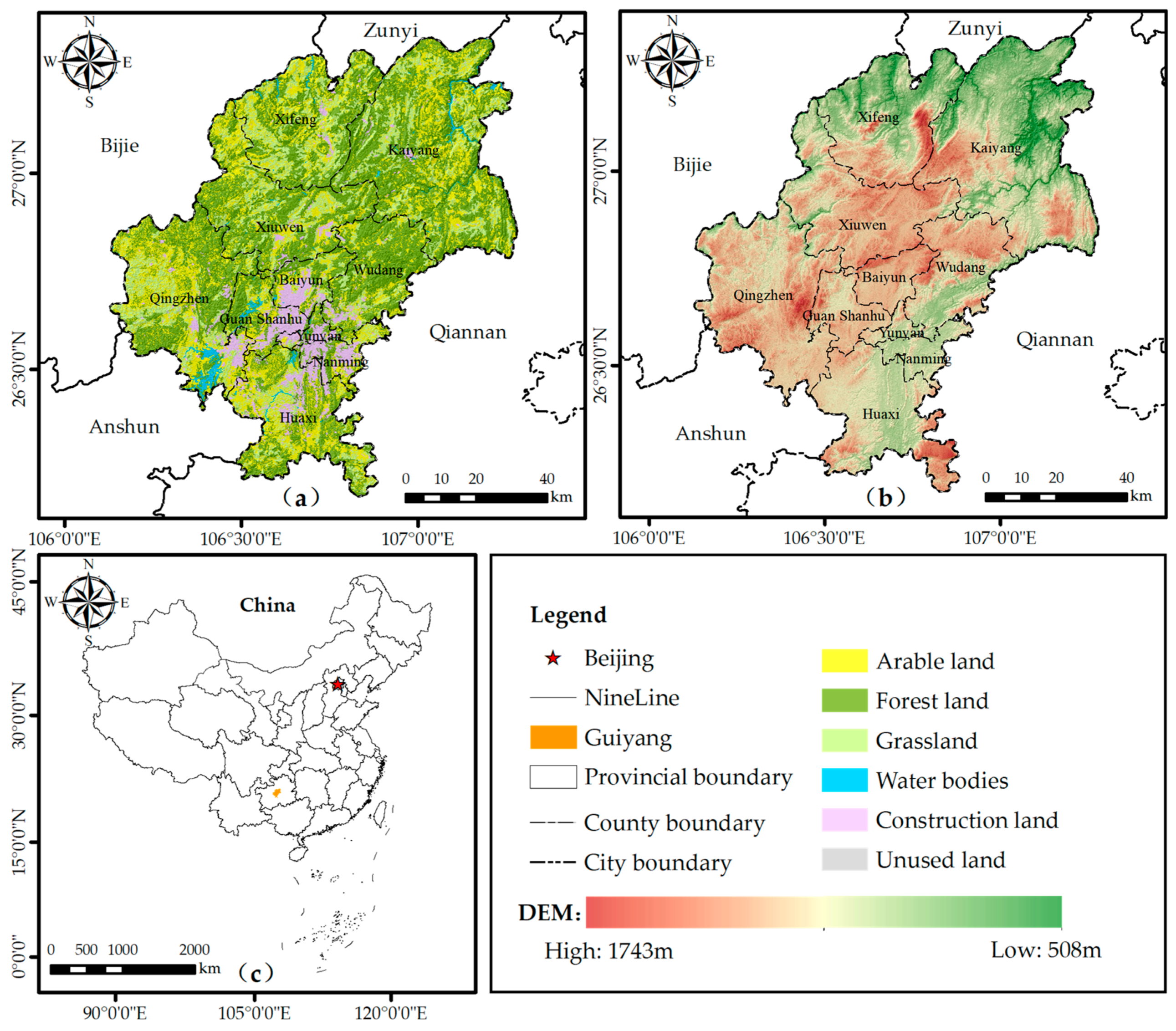
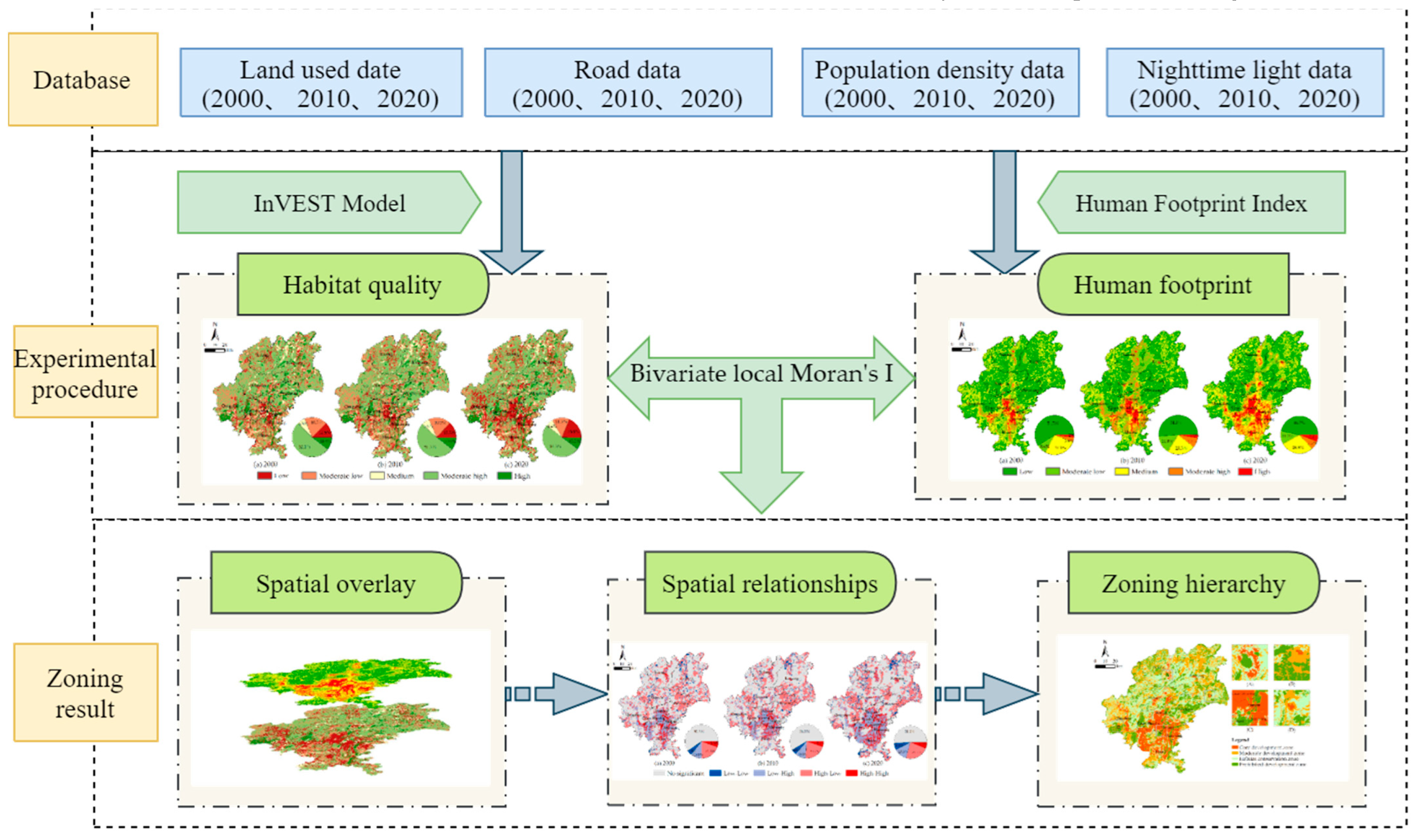

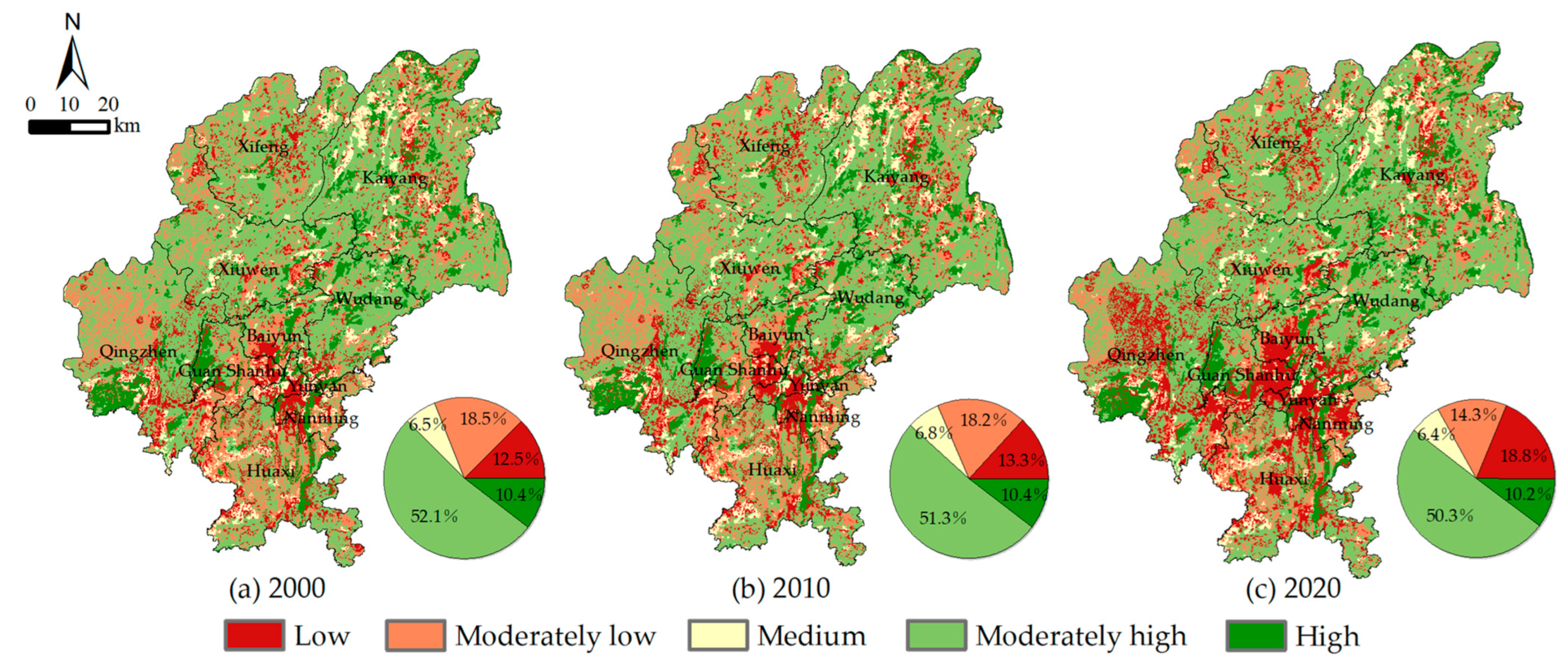

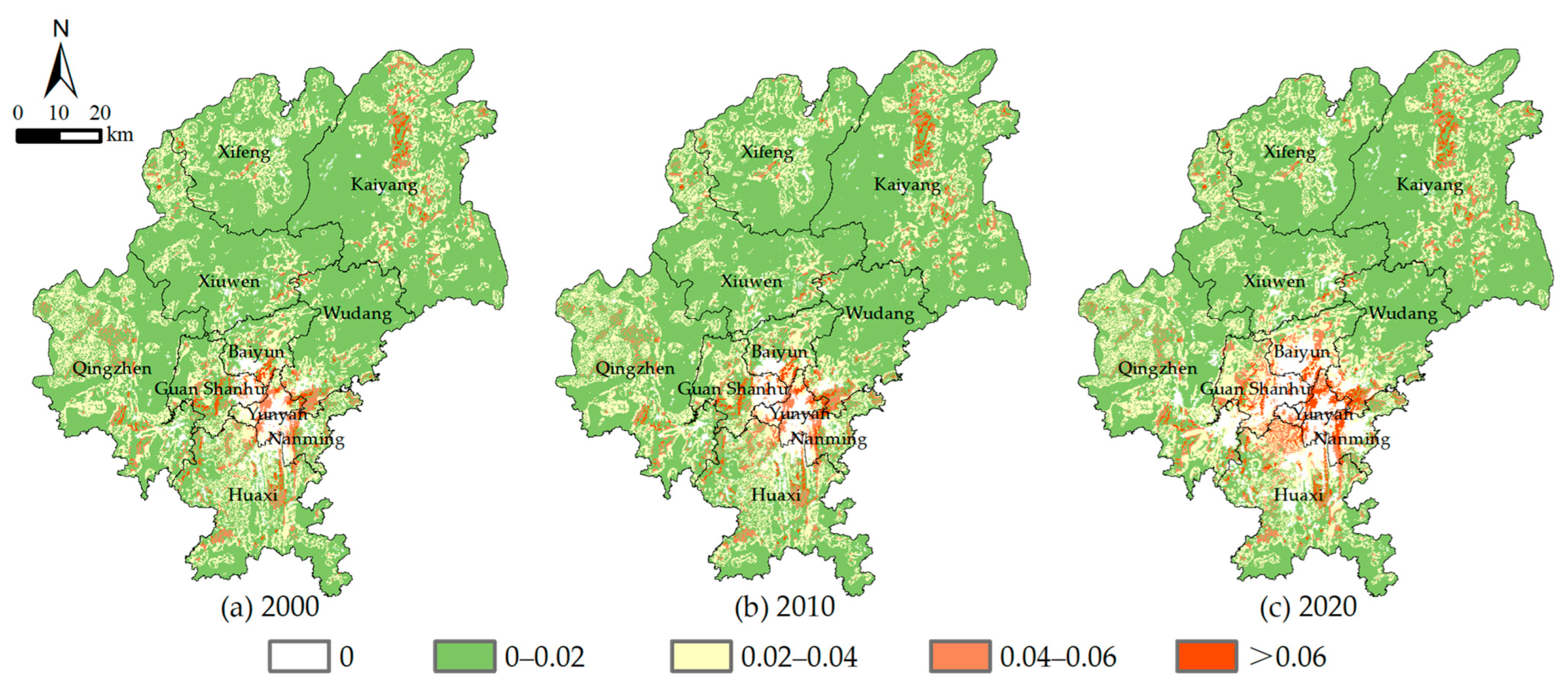
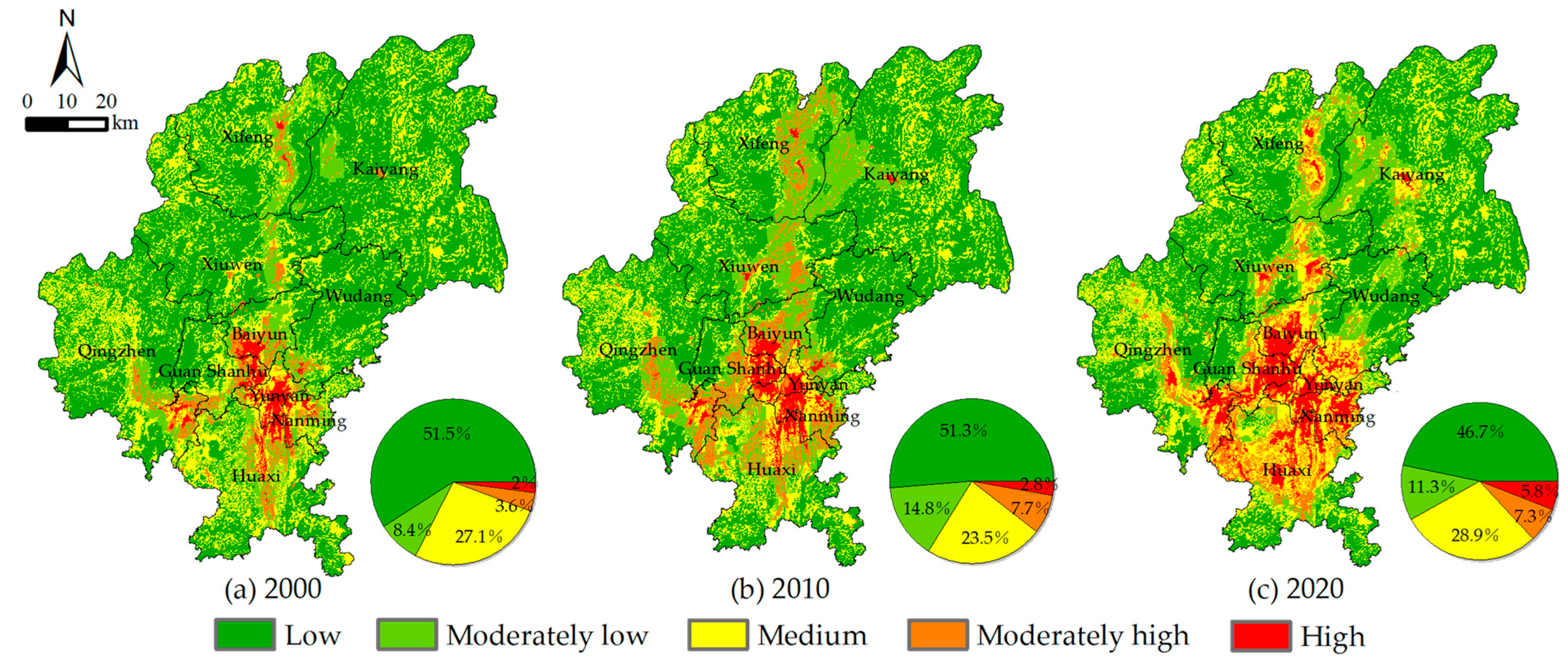
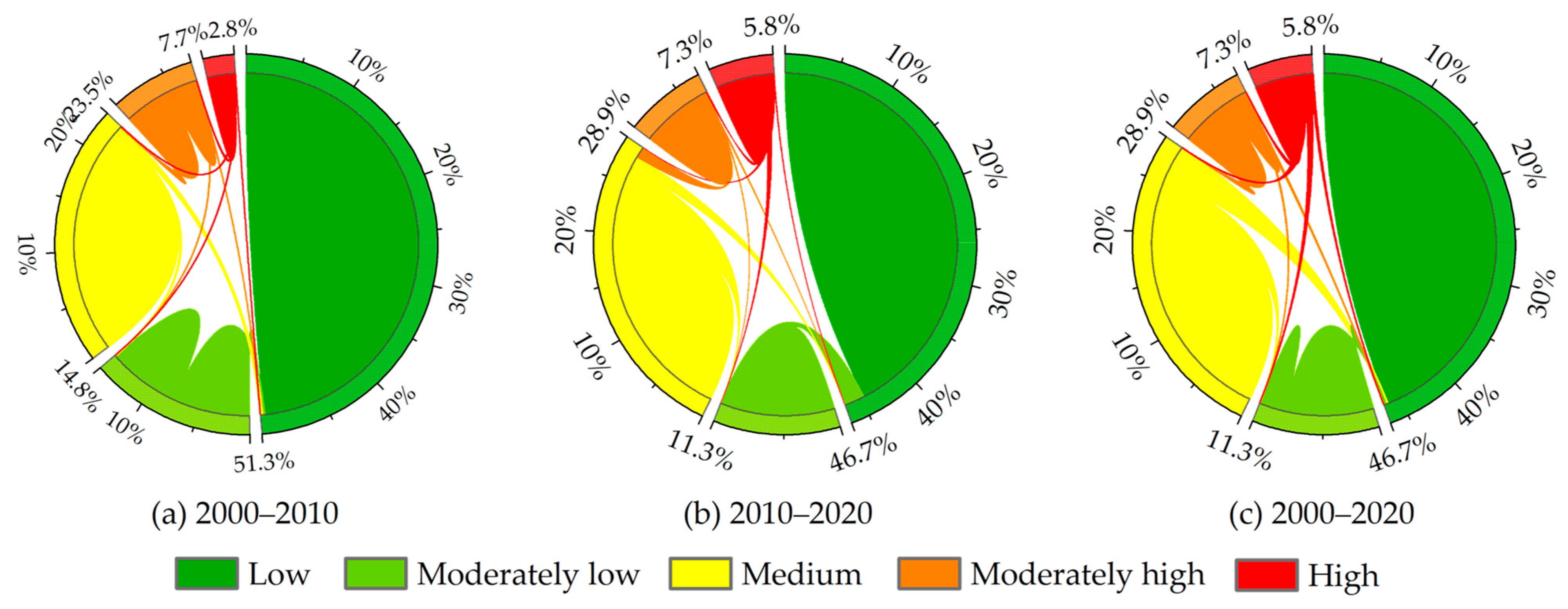

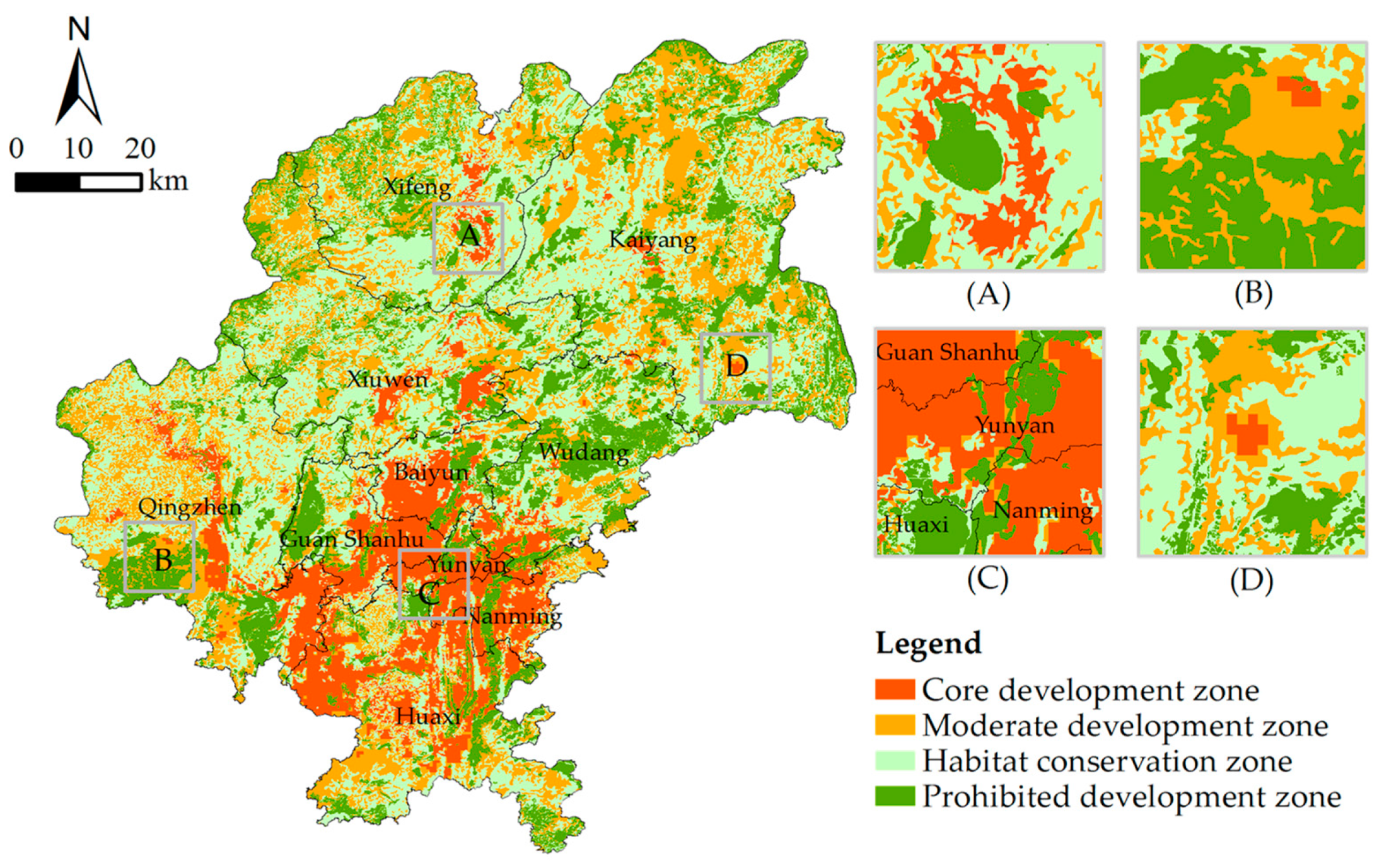
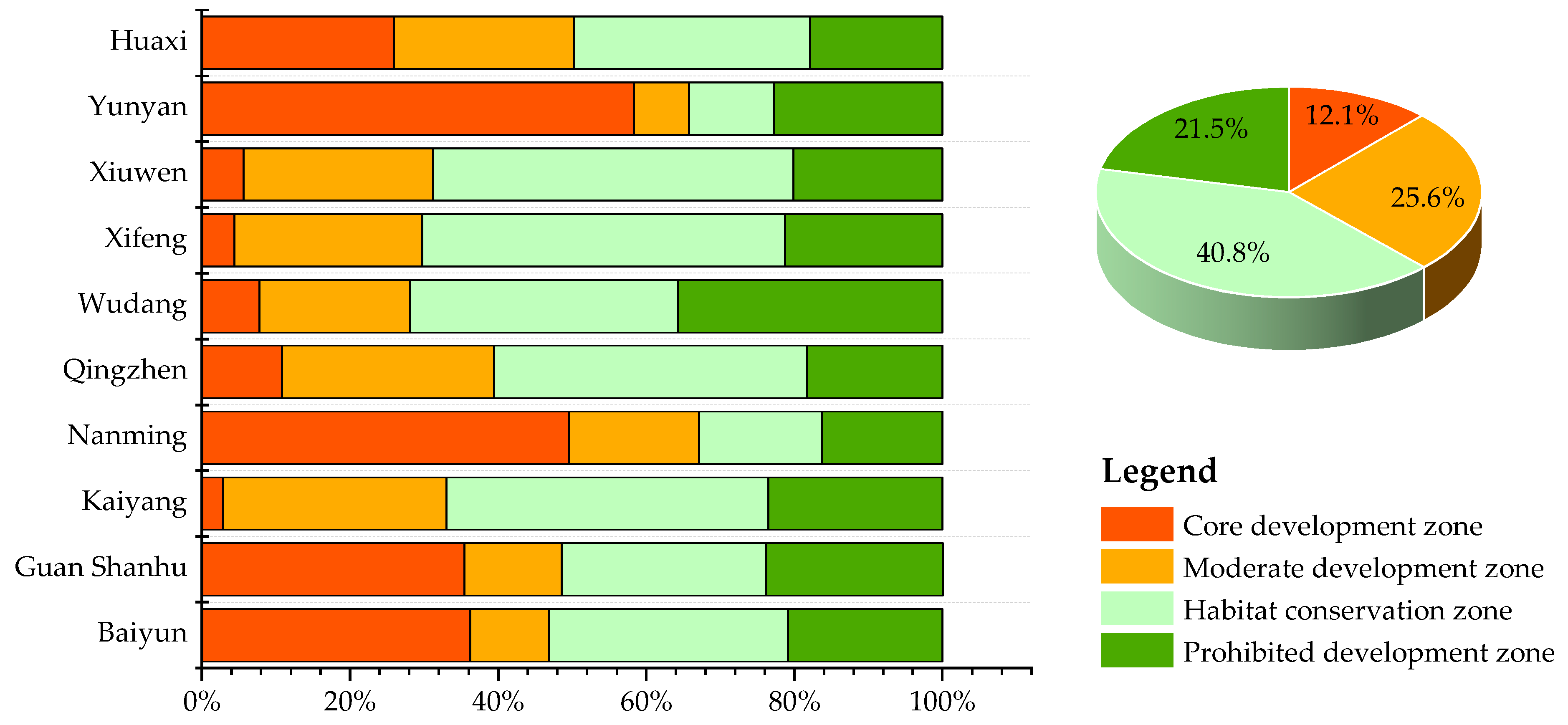
| Data Name | Resolution | Period | Data Source |
|---|---|---|---|
| Land use data | Vector | 2000, 2010, 2020 | http://www.resdc.cn/, accessed on 3 March 2022 |
| DEM data | Raster, 30 m | 2015 | http://www.gscloud.cn/, accessed on 3 March 2022 |
| Population density data | Raster, 1 km | 2000, 2010, 2020 | http://www.resdc.cn/, accessed on 8 March 2022 |
| Road data | Vector | 2000, 2010, 2020 | http://www.resdc.cn/, accessed on 8 March 2022 |
| Night time light data | Raster, 1 km | 2000, 2010, 2020 | https://eogdata.mines.edu/products/vnl/, accessed on 3 April 2022 |
| Threats | Max Distance of Influence (km) | Weight | Decay Type |
|---|---|---|---|
| Paddy field | 1.0 | 0.5 | Linear |
| Arid land | 2.0 | 0.7 | Linear |
| Urban land | 6.0 | 1.0 | Exponential |
| Rural settlements | 3.0 | 0.8 | Exponential |
| Other construction land | 4.0 | 0.7 | Exponential |
| Unused land | 1.0 | 0.5 | Linear |
| Land Use Type | Habitat Suitability | Paddy Field | Arid Land | Urban Land | Rural Settlements | Other Construction Land | Unused Land |
|---|---|---|---|---|---|---|---|
| Paddy field | 0.4 | 0.0 | 0.2 | 0.5 | 0.3 | 0.2 | 0.0 |
| Arid land | 0.2 | 0.2 | 0.0 | 0.5 | 0.2 | 0.2 | 0.1 |
| Woodland | 1.0 | 0.8 | 0.8 | 1.0 | 0.8 | 0.6 | 0.4 |
| Shrub wood | 0.8 | 0.4 | 0.4 | 0.6 | 0.4 | 0.2 | 0.2 |
| Sparse forest | 0.6 | 0.8 | 0.8 | 1.0 | 0.8 | 0.2 | 0.4 |
| Other woodland | 0.6 | 0.6 | 0.6 | 0.9 | 0.8 | 0.5 | 0.4 |
| High-coverage grassland | 0.8 | 0.7 | 0.7 | 0.9 | 0.8 | 0.6 | 0.3 |
| Moderate-coverage grassland | 0.7 | 0.4 | 0.4 | 0.6 | 0.5 | 0.3 | 0.2 |
| Low-coverage grassland | 0.6 | 0.3 | 0.3 | 0.6 | 0.4 | 0.4 | 0.2 |
| Graff | 0.9 | 0.7 | 0.7 | 0.8 | 0.6 | 0.4 | 0.2 |
| Lake | 0.8 | 0.7 | 0.7 | 0.8 | 0.6 | 0.4 | 0.2 |
| Reservoir | 0.8 | 0.7 | 0.7 | 0.9 | 0.7 | 0.5 | 0.4 |
| Urban land | 0.0 | 0.0 | 0.0 | 0.0 | 0.0 | 0.0 | 0.0 |
| Rural settlements | 0.0 | 0.0 | 0.0 | 0.0 | 0.0 | 0.0 | 0.0 |
| Other construction land | 0.0 | 0.0 | 0 | 0.0 | 0.0 | 0.0 | 0.0 |
| Unused land | 0.1 | 0.1 | 0.1 | 0.4 | 0.3 | 0.3 | 0.0 |
Publisher’s Note: MDPI stays neutral with regard to jurisdictional claims in published maps and institutional affiliations. |
© 2022 by the authors. Licensee MDPI, Basel, Switzerland. This article is an open access article distributed under the terms and conditions of the Creative Commons Attribution (CC BY) license (https://creativecommons.org/licenses/by/4.0/).
Share and Cite
Gao, S.; Yang, L.; Jiao, H. Spatio-Temporal Analysis of the Effects of Human Activities on Habitat Quality: A Case Study of Guiyang City, Guizhou Province, China. Land 2022, 11, 1837. https://doi.org/10.3390/land11101837
Gao S, Yang L, Jiao H. Spatio-Temporal Analysis of the Effects of Human Activities on Habitat Quality: A Case Study of Guiyang City, Guizhou Province, China. Land. 2022; 11(10):1837. https://doi.org/10.3390/land11101837
Chicago/Turabian StyleGao, Shunqian, Liu Yang, and Hongzan Jiao. 2022. "Spatio-Temporal Analysis of the Effects of Human Activities on Habitat Quality: A Case Study of Guiyang City, Guizhou Province, China" Land 11, no. 10: 1837. https://doi.org/10.3390/land11101837
APA StyleGao, S., Yang, L., & Jiao, H. (2022). Spatio-Temporal Analysis of the Effects of Human Activities on Habitat Quality: A Case Study of Guiyang City, Guizhou Province, China. Land, 11(10), 1837. https://doi.org/10.3390/land11101837







